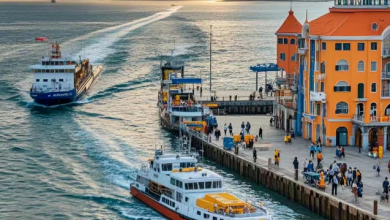Does Dongguan Have A Aiport?

Dongguan, often hailed as the “world’s factory,” has long been one of China’s economic powerhouses. As a recognized new first-tier city, it stands out with a strong industrial base, robust foreign investment, and impressive GDP rankings. However, despite its economic success, one question continues to puzzle many: Why doesn’t Dongguan have its own airport?
This seems particularly surprising when compared with many smaller or less economically developed second- and third-tier cities in China, which already operate regional airports. Given Dongguan’s financial capabilities and global connections, why hasn’t it followed suit?
Which Airport is Closest to Dongguan?
The closest airport to Dongguan is Shenzhen Bao’an International Airport. According to Baidu Maps, it takes only 63 minutes by car from Dongguan city center to reach the airport, covering a distance of 67.3 kilometers with just five traffic lights along the way.
In fact, this travel time is comparable to commuting within a large city. For example, getting to Bao’an Airport from Dongguan might even be faster than traveling from Longgang District within Shenzhen itself—depending on traffic conditions.
The second closest airport is Guangzhou Baiyun International Airport, which takes about 84 minutes to drive from Dongguan city center, covering 81.5 kilometers and passing seven traffic lights. Interestingly, people living in some parts of Guangzhou—like Shunde, Nansha, or Panyu—may actually take longer to reach Baiyun Airport than Dongguan residents do.
Thanks to its strategic location between two major international airports, Dongguan travelers enjoy convenient access to top-tier air travel infrastructure—whether flying through Shenzhen or Guangzhou. No wonder Dongguan has never built its own airport; for now, it simply hasn’t been necessary.
If you’re heading to Shenzhen or Guangzhou airport and don’t want to drive, Dongguan has multiple airport shuttle terminals within the city. For example, the Nancheng Terminal is located at:
No. 1, Hongcheng Hardware City, Nancheng District, Dongguan.
These terminals provide an easy and efficient alternative for catching your flight.

1. Proximity to Major Airports
One of the main reasons is geographical advantage. Within a 100-kilometer radius of Dongguan, there are six airports: Shenzhen Bao’an International Airport, Guangzhou Baiyun International Airport, Hong Kong International Airport, Huizhou Pingtan Airport, Foshan Shadi Airport, and Guangzhou Shawan Airport. These airports offer extensive domestic and international flight options, and are easily accessible by expressways and high-speed rail.
For this reason, building an airport in Dongguan is seen by many as unnecessary and potentially redundant.
2. Airspace Constraints in the Pearl River Delta
The Pearl River Delta is one of the busiest and most congested airspaces in all of China. Even if Dongguan builds an airport, it would face major challenges in securing air routes. The region already sees intense competition for flight slots. This is similar to the situation in Suzhou, a fellow manufacturing giant, which also lacks an airport despite years of lobbying.
Simply put: there is no room in the skies for more flights in this region.
3. Infrastructure Priorities
Dongguan’s transportation infrastructure has long lagged behind its economic development. Public transportation is relatively underdeveloped, and the city is heavily reliant on private vehicles. Many residents prefer or are forced to drive due to the limited coverage of metro and bus systems.
As some locals say, Dongguan doesn’t lack an airport—it lacks basic urban connectivity. Massive investments are still needed in public transport, road networks, and metro systems before considering larger projects like an airport.
4. Land and Environmental Constraints
Although Dongguan has over 2,400 square kilometers of land, land use is tight due to extensive industrial zones and dense urban development. Building a full-scale airport would require massive land acquisition and create significant environmental and noise pollution challenges, especially in central or western Dongguan where most of the population is concentrated.
Some suggest Dongguan could adopt a “shared airport” model like the Foshan-Zhaoqing Airport, where facilities are split across city borders. For example, the airport terminal could be in Dongguan, but the runway located in neighboring Huizhou or Shenzhen. However, such projects require complex inter-city coordination and high costs.
5. Financial Limitations
Despite impressive GDP numbers, Dongguan is under tier-3 fiscal administration, meaning much of its tax revenue is allocated upwards to provincial or central governments. The city has limited discretionary funds, and even essential infrastructure like the Dongguan Metro Line 1 has faced repeated delays due to financial constraints.
As one local sarcastically put it: “Dongguan’s GDP looks shiny, but there’s not much cash in hand.”
Conclusion
While the idea of a Dongguan airport is tempting and could offer strategic advantages in investment and logistics, the real-world constraints—airspace, geography, finances, and existing infrastructure—make it a low priority at best.
Dongguan thrives because of its unique decentralized structure, strong manufacturing base, affordable living, and proximity to major cities like Shenzhen and Guangzhou. Rather than chasing high-profile projects like airports, the city might be better off continuing to improve public transport, optimize land use, and strengthen its innovation and industrial chains.
Sometimes, not having an airport is less a sign of weakness—and more a reflection of strategic focus.





